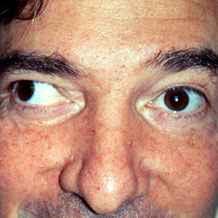 What it is:
What it is:
Strabismus (struh-BIS-mus) is a condition in which the eyeballs point in different directions.
What You Need To Do:
Your ophthalmologist (Eye M.D.) may suggest surgery, eye exercises, or other treatments to help your eyes focus.
Why It’s Important:
To correct their inability to focus properly, many adults with strabismus have to tilt or turn their heads when focusing. They also are unable to make direct eye contact with both eyes when looking at people, which can make social situations awkward.
Symptoms
Adults with strabismus may experience any or all of these symptoms:
- eye fatigue
- double vision
- overlapped or blurred images
- a pulling sensation around the eyes
- reading difficulty
- loss of depth perception
Treatment
Adult strabismus has different causes. Depending on the cause, strabismus can be treated several different ways.
Eye muscle surgery is the most common treatment for strabismus. Typically, strabismus occurs when the muscles surrounding the eyes act as though they are either too stiff or too weak. Your Eye M.D. can surgically loosen, tighten, or reposition certain eye muscles so that the eyes will be able to look straight. More than one surgery may be needed.
Eye muscle exercises can be helpful in treating a form of adult strabismus in which the eyes cannot align themselves for close work or reading. The eye exercises help re-train the eyes to focus inward together.
Eyeglasses with prisms can correct mild double vision associated with adult strabismus. A prism is a clear, wedge-shaped lens that bends, or refracts, light rays. For adults with mild double vision, the prism eyeglasses realign images together so that the eyes see only one image.
If an overactive eye muscle is the cause of the strabismus, Botox injections can help. Botox is a drug that, when injected in small amounts, temporarily paralyzes muscles. It can last several months and may even result in a permanent change in eye alignment.
Tests/Diagnosis
There are two tests commonly used to diagnose strabismus. With a cover test your Eye M.D. will cover each eye one at a time while you look at an object in the room. Depending on how the eye shifts when the cover is moved, strabismus can be diagnosed.
A flashlight can be used to test the alignment of the eyes. As you look at the light, your Eye M.D. can see a reflection on the front surface of your eye. If your eyes are properly aligned, the reflection will be in the same spot of each eye. If strabismus is present, the reflection from the light will not be in the same spot of each eye.
Causes/Risk Factors
Nearly four in every 100 adults have strabismus. It can be a disorder of the brain or a disorder of one or more muscles that move the eyes.
Strabismus may be classified as unilateral/constant if the same eye constantly turns in or out, or alternating/intermittent if the eye only turns in or out sometimes. Most adults with strabismus have had the condition since childhood.
Acquired strabismus begins in adulthood due to medical problems such as diabetes, thyroid disease, myasthenia gravis, brain tumors, head trauma, or strokes. Occasionally, a cataract or a tumor in the eye can cause strabismus. These conditions may require urgent medical attention.
The vast majority of people with strabismus, however, have none of these problems Occasionally, misalignment of the eyes can occur after an eye surgery such as cataract surgery or retinal surgery.
(Information provided by EyeCareAmerica)

